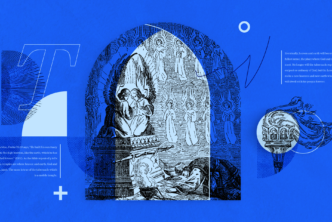We’ve all read or heard it this season: “Behold, the virgin shall be with child and shall bear a son, and they shall call his name Immanuel.” This famous line is read from Matthew 1:23 or Isaiah 7:14 every Christmas season, in reference to the birth of Jesus. But in Isaiah 7, is this a strictly messianic prophecy?
The context of Isaiah 7:14
Again the Lord spoke to Ahaz, “Ask a sign of the Lord your God; let it be deep as Sheol or high as heaven.” But Ahaz said, “I will not ask, and I will not put the Lord to the test.” And he said, “Hear then, O house of David! Is it too little for you to weary men, that you weary my God also? Therefore the Lord himself will give you a sign. Behold, the virgin shall conceive and bear a son, and shall call his name Immanuel. He shall eat curds and honey when he knows how to refuse the evil and choose the good. For before the boy knows how to refuse the evil and choose the good, the land whose two kings you dread will be deserted. The Lord will bring upon you and upon your people and upon your father’s house such days as have not come since the day that Ephraim departed from Judah—the king of Assyria.” (Isaiah 7:10–17)
Ahaz, the king of Judah at this time, is being addressed by God. God promised he would defeat the kings from the north who threatened Ahaz’s kingdom, and he now asks Ahaz to test God to see that his word is true. However, it becomes apparent that Ahaz is the one being tested. Ahaz refuses to put the Lord to the test, but God still revealed a sign to him.
The sign is that the virgin (עַלְמָ֗ה) shall conceive and bear a son, and she will name him “God with us.” And before the child “knows how to refuse the evil and choose the good,” the two threatening kings will be destroyed. Thus God’s promise will be fulfilled. However, there remains a downside to this sign as well: “The Lord will bring upon you and upon your people and upon your father’s house such days as have not come since the day that Ephraim departed from Judah—the king of Assyria.” As Carson and Beale put it, “before that [the sign] can be interpreted as very good news, the prophet adds that they will be replaced by an even worse invader: Assyria” (Carson & Beale, Commentary on the New Testament Use of the Old, 5).
Before we look at the possibility of a twice-fulfilled prophecy, we need to deal with the issue of עַלְמָה (ʿalmâ) and its meaning.
עַלְמָה (ʿalmâ) as virgin and maiden
Many modern English translations render ʿalmâ as “virgin” (ESV, NASB, HCSB, NIV, etc.), while others use “young woman” or something similar. In Hebrew there is a word that would better denote virginity (בְּתוּלָה), as well as a word that would more clearly refer to a young woman (אִשָּׁה), so why this word in this context?
John Oswalt, in his NICOT volume on Isaiah, is helpful on this point. He reminds us that it is “not possible to be dogmatic as to why Isaiah used the ambiguous ʿalmâ here instead of the unambiguous beṯûlâ.” He notes that the typical meaning prescribed to ʿalmâ is “a young woman of marriageable age,” (quite similar to the English “maiden”) “with the clear implication that the conception is a natural one” (Oswalt, The Book of Isaiah, Chapters 1–39, 211). As he is quick to point out, however, many conservative scholars demonstrate that the word is not used to reference a married woman in the Old Testament; thus it must refer to a “sexually mature, but unmarried, woman.” In the Hebrew culture, this would certainly also imply virginity. Oswalt goes on to discuss the Septuagint translation of the word and a possible dual-focus.
Such an understanding has the significant virtue of explaining the origin of the LXX parthénos, “virgin,” something those commentators opting for “a young woman of marriageable age” do not mention. Unless ʿalmâ had overtones of virginity about it, the LXX translation is inexplicable. . . .
Possibly, then, it is the dual focus of the oracle that explains the use of ʿalmâ here. In the short term, the virgin conception does not seem to have had primary importance. Rather, the significance is that a child conceived at that moment would still be immature when the two threatening nations would have been destroyed (vv. 16, 22). Had Isaiah used beṯûlâ here, Ahaz would probably have been so caught up with that thought that he would have missed the specific linkage to his own time. (Oswalt, 212)
Could Isaiah have used עַלְמָה to allow for both an imminent fulfillment of the word by a “maiden” as well as a future and final fulfillment by a virgin?
Multiple-fulfillment prophecy
When speaking of “prophetic fore-telling,” Blomberg, Klein, and Hubbard state that “an OT prophecy may have two fulfillments, one near the prophet’s lifetime, and one long past it” (Blomberg, Klein, & Hubbard, An Introduction to Biblical Interpretation, 378). He cites 2 Samuel 7:12–16 as an example, with its immediate fulfillment in 1 Kings 1–2 in the coronation of Solomon. However, Blomberg also points to Hebrews 1:5, which applies the prophecy of 2 Samuel to Jesus, not merely as David’s son, but as God’s. “Sound theology,” he posits, “undergirds the idea of such multiple fulfillments—belief that God rules all human history and can bring about both ‘sons.’”
Another prophecy commonly seen as having a dual fulfillment occurs in Luke 21:5–9, where many scholars say Jesus predicts both the destruction of the temple in AD 70 and the end of the age, immediately prior to the parousia. Indeed, the Bible seems to be full of these sorts of prophecies.
“Who is this special child?”
Does the prophecy in Isaiah 7 carry only messianic implications, or was there a more immediate (or provisional) fulfillment in Isaiah’s day? Carson and Beale point out that “only a handful of very conservative scholars insist on seeing solely a messianic prophecy here, most recognize that there is at least a provisional fulfillment in Isaiah’s day, given the explicit statements of 7:15–16” (Carson & Beale, 5).
Given the possibility of a provisional fulfillment, there are several possibilities of who this child may be. Some suggest King Hezekiah (Oswalt points out that “honey and curds” has royal implications in Ancient Near East contexts), some an unknown prophet, and others “a collective remnant in Israel.” However, Beale, Carson, and Oswalt all suggest that the most likely possibility is Isaiah’s own son, Maher-Shalal-Hash-Baz. For in Isaiah 8:3–4, the prophetess conceives and bears a son, and “before the boy knows how to cry ‘My father’ or ‘My mother,’ the wealth of Damascus and the spoil of Samaria will be carried away before the king of Assyria.” In this statement we see striking similarities to the prophecy of 7:14, particularly in the fate of the two northern kingdoms and the dominion of the Assyrians. Carson and Beale continue to explain:
This same son is called “Immanuel” in 8:8, which is explained in 8:10 as “God with us,” accounting for Matthew’s linking the two portions of Isaiah together. In 8:18 Isaiah describes his two sons, Maher-Shalal-Hash-Baz and Shear-Jashub (cf. 7:3), as “signs and symbols in Israel,” which description ties back in with the sign God promised in 7:11, 14. But in 9:1–7 the more distant future is in view, as exiles are once again restored to Galilee. Here, in 9:6, another description of the birth of a wonderful child appears, one who can be called “Almighty God,” “Eternal Father,” and “Prince of Peace,” who will rule from David’s throne and establish universal justice forever—prophecies that scarcely could have been fulfilled in a mere earthly king. (Carson & Beale, 5)
Likewise, Oswalt notes that “this passage would form a more poetic statement of the child’s identity, pointing to the ultimate Immanuel, whereas 8:1–4 would constitute a more prosaic account and be limited merely to the person of Maher-shalal-hash-baz. The references to his conception and birth in 8:3 lend support to the connection, as does the reference to Immanuel in 8:10, shortly after the discussion of the birth of Isaiah’s son” (Oswalt, 213).
A final fulfillment
Whatever our stance on multiple fulfillment in light of Isaiah’s Immanuel, we can stand firm on Matthew 1:23, knowing that this prophecy finds its final and ultimate fulfillment in the birth of Jesus the Christ, God with us. Like in Isaiah, the birth of Jesus was a sign of the destruction of an oppressing kingdom. Oswalt rightly notes, God’s presence with his people can have both positive and negative effects, bringing both joy and sorrow, “depending upon the people’s character.” As Isaiah’s prophecy brought about a positive (destruction of the northern kingdoms) and a negative (the terrifying reign of the Assyrian king), so too Jesus’ birth brings about joy for those found in him and sorrow for the unrepentant who reject him.
Resources for further study
- The New International Commentary on the Old Testament: The Book of Isaiah, Chapters 1–39 by John N. Oswalt
- Commentary on the New Testament Use of the Old by D. A. Carson and G. K. Beale
- Introduction to Biblical Interpretation by Craig L. Blomberg, William Klein, and Robert L. Hubbard Jr.
Get all three in Logos Bible Software today.




